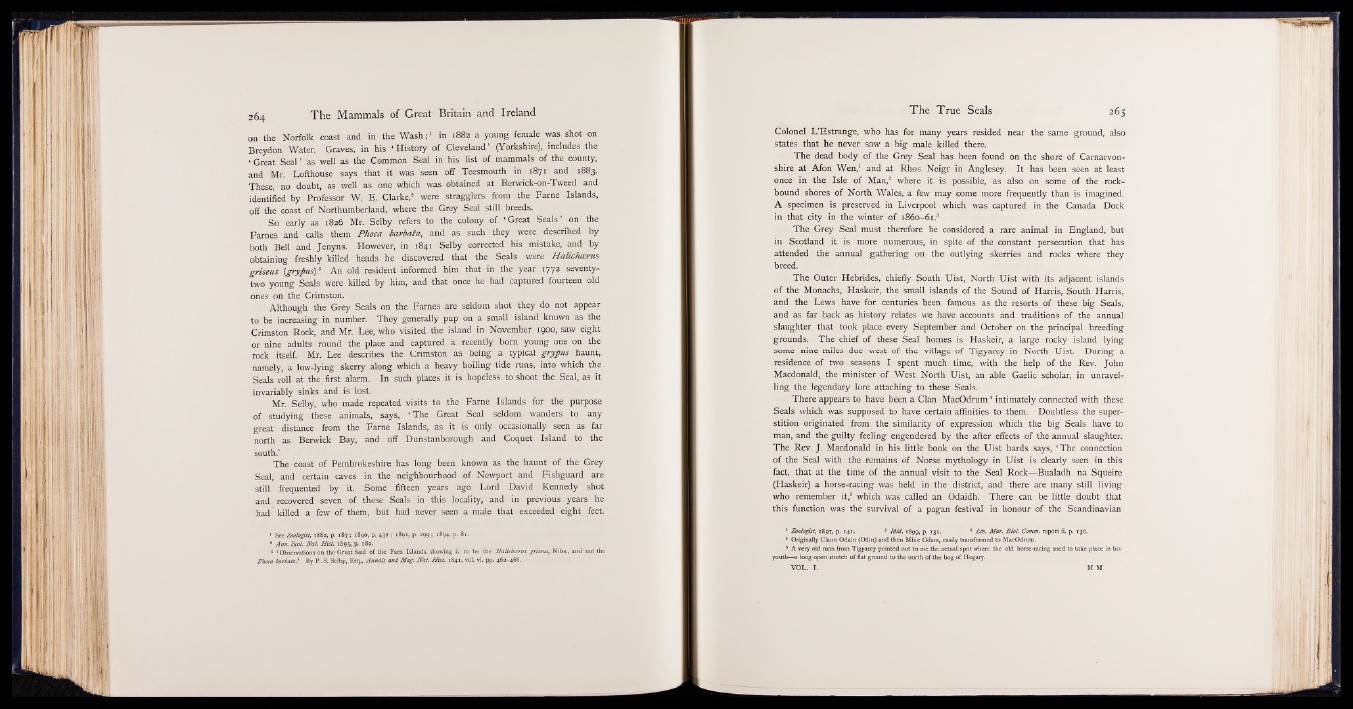
on the Norfolk coast and in the Wash; 1 in 1882 a young female was shot on
Breydon Water. Graves, in his ‘ History of Cleveland' (Yorkshire), includes the
‘ Great Seal ’ as well as the Common Seal in his list of mammals of the county,
and Mr. Lofthouse says that it was seen off Teesmouth in 1871 and 1883.
These, no doubt, as well as one which was obtained at Berwick-on-Tweed and
identified by Professor W. E. Clarke,1 2 3 were stragglers from the Fame Islands;,
off the coast of Northumberland, where the Grey Seal still breeds.
. So early as 1826 Mr. Selby refers to the colony of ‘ Great Seals' on the
Fames and calls them Phoca barbata, and as such they were described by
both Bell and Jenyns. However, in 1841 Selby corrected his mistake, and by
obtaining freshly killed heads he discovered that the Seals were Halicharus
griseus igvypus')? An old resident informed him that in the year 177^ seventy-
two young Seals were killed by him, and that once he had captured fourteen old
ones on the Crimston.
Although the Grey Seals on the Fames are seldom shot they do not appear
to be increasing in number. They generally pup on a small island known as the
Crimston Rock, and Mr. Lee, who visited the island in November 1900, saw eight
or nine adults round the place and captured a recently born young one on the
rock itself. Mr. Lee describes the Crimston as being a typical gryfus haunt,
namely, a low-lying skerry along which a heavy boiling tide runs, into which the
Seals roll at the first alarm. In such places j | is hopeless to shoot the .Seal, as it
invariably sinks and is lost.
Mr. Selby, who made repeated visits to the Fame Islands for the purpose
of studying these animals, says, ‘ The Great Seal seldom wanders to any
great distance from the Fame Islands, as it is only occasionally seen as far
north as Berwick Bay, and off Dunstanborough and Coquet Island to the
south.’
The coast of Pembrokeshire has long been known as the haunt of the Grey
Seal, and certain caves, in the neighbourhood of Newport and ' Fishguard are
still frequented by it. Some fifteen years ago Lord David Kennedy shot
and recovered seven of these Seals in this locality, and in previous years he
had killed a few of them, but had never seen a male that exceeded eight feet.
1 See Zoologist, 1882, p. 187; 1890, p. 432 ; 1891, p. 299; 1894, p. 81.
* Ann. Scot. Nat. Hist. 1893, p. 180.
3 1 Observations on the Great Seal of the Farn Islands, showing it to be the Halichosrus griseus, Nilss., and not the
Phoca barbata.' By P. S. Selby, Esq., Annals and Mag. Nat. H ist. 1841, vol. vi. pp. 462-466.
Colonel L'Estrange, who has for many years resided near the same ground, also
states that he never saw a big male killed there.
The dead body of the Grey Seal has been found on the shore of Carnarvonshire
at Afon Wen,1 and at Rhos Neigr in Anglesey. It has been seen at least
once in the Isle of Man,2 where it is possible, as also on some of the rock-
bound shores of North Wales, a few may come more frequently than is imagined.
A specimen is preserved in Liverpool which was captured in the Canada Dock
in that city in the winter of 1860-61.8
The Grey Seal must therefore be considered a rare animal in England, but
in Scotland it is more numerous, in spite of the constant persecution that has
attended the annual gathering on the outlying skerries and rocks where they
breed.
The Outer Hebrides, chiefly South Uist, North Uist with its adjacent islands
of the Monachs, Haskeir, the small islands of the Sound of Harris, South Harris,
and the Lews have for centuries been famous as the resorts of these big Seals,
and as far back as history relates we have accounts and traditions of the annual
slaughter that took place every September and October on the principal breeding
grounds. The chief of these Seal homes is Haskeir, a large rocky island lying
some nine miles due west of the village of Tigyarey in North Uist. During a
residence of two seasons I spent much time, with the help of the Rev. John
Macdonald, the minister of West North Uist, an able Gaelic scholar, in unravelling
the legendary lore attaching to these Seals.
There appears to have been a Clan MacOdrum4 intimately connected with these
Seals which was supposed to have certain affinities to them. Doubtless the superstition
originated from the similarity of expression which the big Seals have to
man, and the guilty feeling engendered by the after effects of the annual slaughter.
The Rev. J. Macdonald in his little book on the Uist bards says, ‘ The connection
of the Seal with the remains of Norse mythology in Uist is clearly seen in this
fact, that at the time of the annual visit to the Seal Rock— Bualadh na Squeire
(Haskeir) a horse-racing was held in the district, and there are many still living
who remember it,6 which was called an Odaidh. There can be little doubt that
this function was the survival of a pagan festival in honour of the Scandinavian
1 Zoologist, 1897, p. 141. * Ibid. 1899, p. 131. * Liv. Mar. Biol. Comm, report ii. p. 136.
* Originally Clann Odain (Odin) and then Mhic Odam, easily transformed to MacOdrum.
8 A very old man from Tigyarey pointed out to me the actual spot where the old horse-racing used to take place in his
youth— a long open stretch of flat ground to the north of the bog of Hogary.
VOL. I. M M